Detailed Examination: Structure of a Cell and Its Functions Biology
VerifiedAdded on 2019/09/30
|8
|2750
|166
Essay
AI Summary
This essay provides a detailed exploration of cell structure and its functions, covering key components such as the cell wall, cell membrane, cytoplasm, and nucleus. It delves into the roles of organelles like mitochondria, endoplasmic reticulum, ribosomes, Golgi apparatus, and lysosomes in cellular processes. The essay also discusses the structure of the cell membrane, including proteins, glycolipids, and the phospholipid bilayer, as well as the fluid mosaic model. It explains the importance of each component, including the nucleus, which controls gene expression, and the mitochondria, which generates energy. The essay also explains the functions of ribosomes in protein synthesis and the Golgi apparatus in packaging proteins. It emphasizes the overall significance of cell structure in the functioning of living organisms.
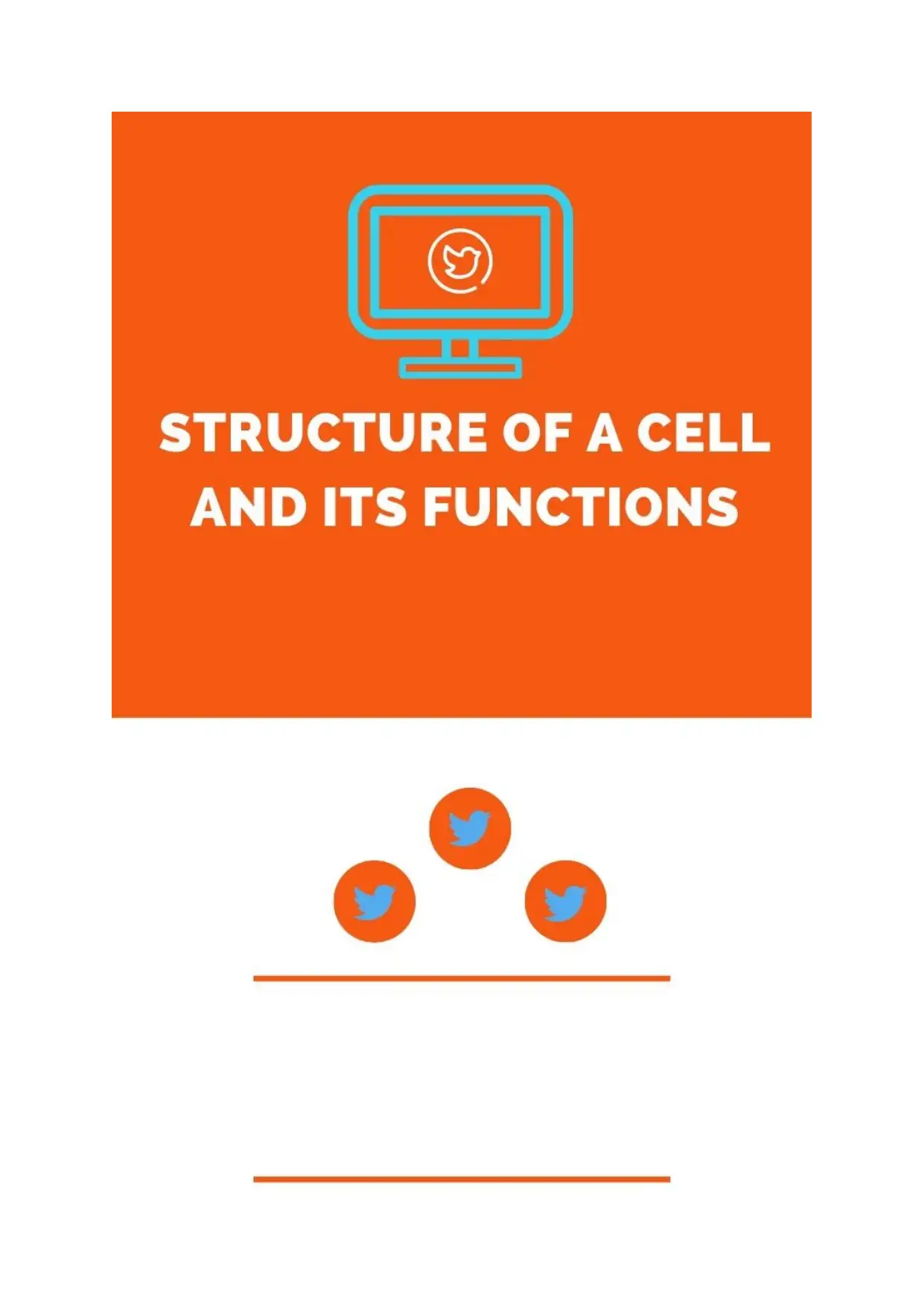
Paraphrase This Document
Need a fresh take? Get an instant paraphrase of this document with our AI Paraphraser
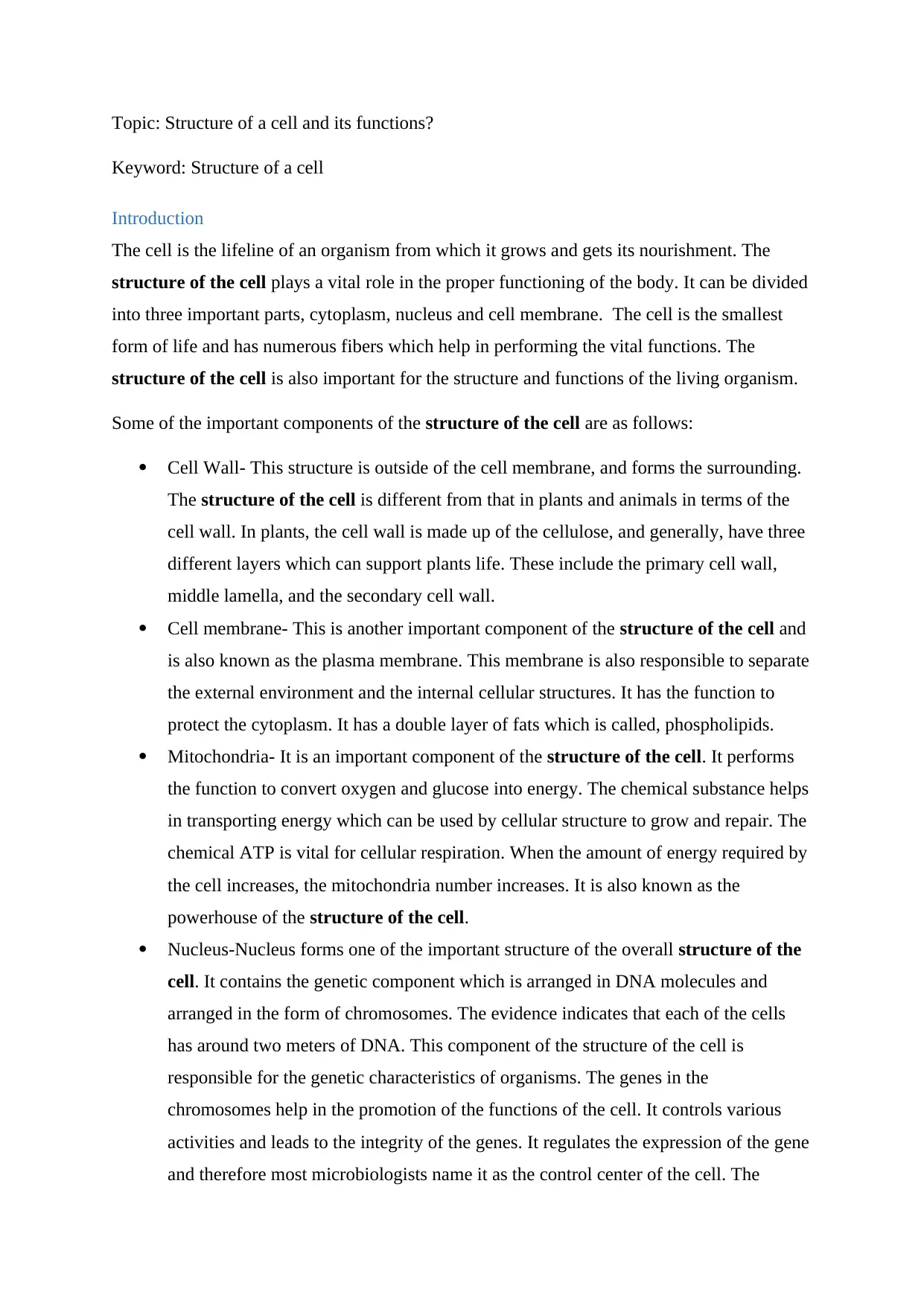
Topic: Structure of a cell and its functions?
Keyword: Structure of a cell
Introduction
The cell is the lifeline of an organism from which it grows and gets its nourishment. The
structure of the cell plays a vital role in the proper functioning of the body. It can be divided
into three important parts, cytoplasm, nucleus and cell membrane. The cell is the smallest
form of life and has numerous fibers which help in performing the vital functions. The
structure of the cell is also important for the structure and functions of the living organism.
Some of the important components of the structure of the cell are as follows:
Cell Wall- This structure is outside of the cell membrane, and forms the surrounding.
The structure of the cell is different from that in plants and animals in terms of the
cell wall. In plants, the cell wall is made up of the cellulose, and generally, have three
different layers which can support plants life. These include the primary cell wall,
middle lamella, and the secondary cell wall.
Cell membrane- This is another important component of the structure of the cell and
is also known as the plasma membrane. This membrane is also responsible to separate
the external environment and the internal cellular structures. It has the function to
protect the cytoplasm. It has a double layer of fats which is called, phospholipids.
Mitochondria- It is an important component of the structure of the cell. It performs
the function to convert oxygen and glucose into energy. The chemical substance helps
in transporting energy which can be used by cellular structure to grow and repair. The
chemical ATP is vital for cellular respiration. When the amount of energy required by
the cell increases, the mitochondria number increases. It is also known as the
powerhouse of the structure of the cell.
Nucleus-Nucleus forms one of the important structure of the overall structure of the
cell. It contains the genetic component which is arranged in DNA molecules and
arranged in the form of chromosomes. The evidence indicates that each of the cells
has around two meters of DNA. This component of the structure of the cell is
responsible for the genetic characteristics of organisms. The genes in the
chromosomes help in the promotion of the functions of the cell. It controls various
activities and leads to the integrity of the genes. It regulates the expression of the gene
and therefore most microbiologists name it as the control center of the cell. The
Keyword: Structure of a cell
Introduction
The cell is the lifeline of an organism from which it grows and gets its nourishment. The
structure of the cell plays a vital role in the proper functioning of the body. It can be divided
into three important parts, cytoplasm, nucleus and cell membrane. The cell is the smallest
form of life and has numerous fibers which help in performing the vital functions. The
structure of the cell is also important for the structure and functions of the living organism.
Some of the important components of the structure of the cell are as follows:
Cell Wall- This structure is outside of the cell membrane, and forms the surrounding.
The structure of the cell is different from that in plants and animals in terms of the
cell wall. In plants, the cell wall is made up of the cellulose, and generally, have three
different layers which can support plants life. These include the primary cell wall,
middle lamella, and the secondary cell wall.
Cell membrane- This is another important component of the structure of the cell and
is also known as the plasma membrane. This membrane is also responsible to separate
the external environment and the internal cellular structures. It has the function to
protect the cytoplasm. It has a double layer of fats which is called, phospholipids.
Mitochondria- It is an important component of the structure of the cell. It performs
the function to convert oxygen and glucose into energy. The chemical substance helps
in transporting energy which can be used by cellular structure to grow and repair. The
chemical ATP is vital for cellular respiration. When the amount of energy required by
the cell increases, the mitochondria number increases. It is also known as the
powerhouse of the structure of the cell.
Nucleus-Nucleus forms one of the important structure of the overall structure of the
cell. It contains the genetic component which is arranged in DNA molecules and
arranged in the form of chromosomes. The evidence indicates that each of the cells
has around two meters of DNA. This component of the structure of the cell is
responsible for the genetic characteristics of organisms. The genes in the
chromosomes help in the promotion of the functions of the cell. It controls various
activities and leads to the integrity of the genes. It regulates the expression of the gene
and therefore most microbiologists name it as the control center of the cell. The
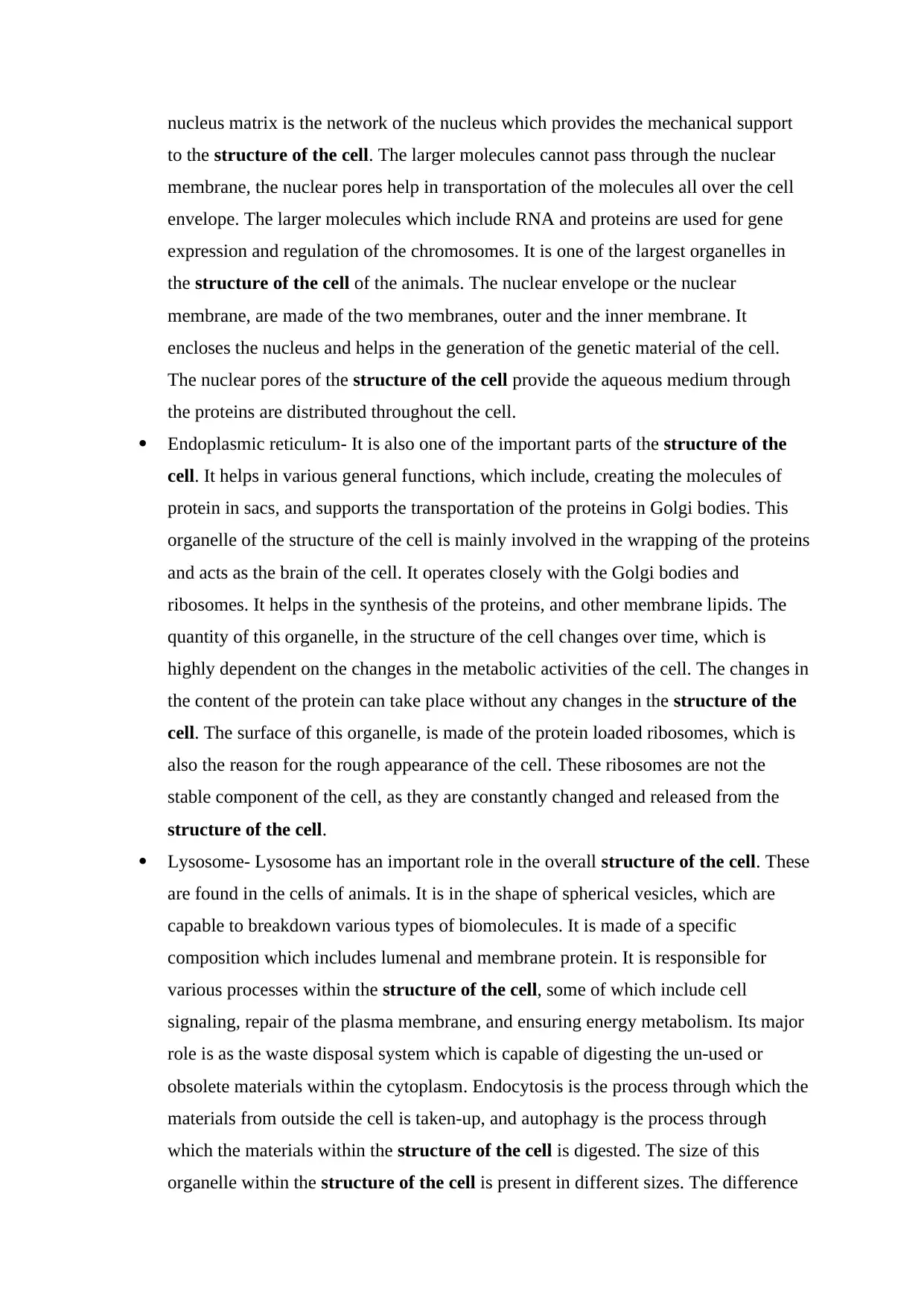
nucleus matrix is the network of the nucleus which provides the mechanical support
to the structure of the cell. The larger molecules cannot pass through the nuclear
membrane, the nuclear pores help in transportation of the molecules all over the cell
envelope. The larger molecules which include RNA and proteins are used for gene
expression and regulation of the chromosomes. It is one of the largest organelles in
the structure of the cell of the animals. The nuclear envelope or the nuclear
membrane, are made of the two membranes, outer and the inner membrane. It
encloses the nucleus and helps in the generation of the genetic material of the cell.
The nuclear pores of the structure of the cell provide the aqueous medium through
the proteins are distributed throughout the cell.
Endoplasmic reticulum- It is also one of the important parts of the structure of the
cell. It helps in various general functions, which include, creating the molecules of
protein in sacs, and supports the transportation of the proteins in Golgi bodies. This
organelle of the structure of the cell is mainly involved in the wrapping of the proteins
and acts as the brain of the cell. It operates closely with the Golgi bodies and
ribosomes. It helps in the synthesis of the proteins, and other membrane lipids. The
quantity of this organelle, in the structure of the cell changes over time, which is
highly dependent on the changes in the metabolic activities of the cell. The changes in
the content of the protein can take place without any changes in the structure of the
cell. The surface of this organelle, is made of the protein loaded ribosomes, which is
also the reason for the rough appearance of the cell. These ribosomes are not the
stable component of the cell, as they are constantly changed and released from the
structure of the cell.
Lysosome- Lysosome has an important role in the overall structure of the cell. These
are found in the cells of animals. It is in the shape of spherical vesicles, which are
capable to breakdown various types of biomolecules. It is made of a specific
composition which includes lumenal and membrane protein. It is responsible for
various processes within the structure of the cell, some of which include cell
signaling, repair of the plasma membrane, and ensuring energy metabolism. Its major
role is as the waste disposal system which is capable of digesting the un-used or
obsolete materials within the cytoplasm. Endocytosis is the process through which the
materials from outside the cell is taken-up, and autophagy is the process through
which the materials within the structure of the cell is digested. The size of this
organelle within the structure of the cell is present in different sizes. The difference
to the structure of the cell. The larger molecules cannot pass through the nuclear
membrane, the nuclear pores help in transportation of the molecules all over the cell
envelope. The larger molecules which include RNA and proteins are used for gene
expression and regulation of the chromosomes. It is one of the largest organelles in
the structure of the cell of the animals. The nuclear envelope or the nuclear
membrane, are made of the two membranes, outer and the inner membrane. It
encloses the nucleus and helps in the generation of the genetic material of the cell.
The nuclear pores of the structure of the cell provide the aqueous medium through
the proteins are distributed throughout the cell.
Endoplasmic reticulum- It is also one of the important parts of the structure of the
cell. It helps in various general functions, which include, creating the molecules of
protein in sacs, and supports the transportation of the proteins in Golgi bodies. This
organelle of the structure of the cell is mainly involved in the wrapping of the proteins
and acts as the brain of the cell. It operates closely with the Golgi bodies and
ribosomes. It helps in the synthesis of the proteins, and other membrane lipids. The
quantity of this organelle, in the structure of the cell changes over time, which is
highly dependent on the changes in the metabolic activities of the cell. The changes in
the content of the protein can take place without any changes in the structure of the
cell. The surface of this organelle, is made of the protein loaded ribosomes, which is
also the reason for the rough appearance of the cell. These ribosomes are not the
stable component of the cell, as they are constantly changed and released from the
structure of the cell.
Lysosome- Lysosome has an important role in the overall structure of the cell. These
are found in the cells of animals. It is in the shape of spherical vesicles, which are
capable to breakdown various types of biomolecules. It is made of a specific
composition which includes lumenal and membrane protein. It is responsible for
various processes within the structure of the cell, some of which include cell
signaling, repair of the plasma membrane, and ensuring energy metabolism. Its major
role is as the waste disposal system which is capable of digesting the un-used or
obsolete materials within the cytoplasm. Endocytosis is the process through which the
materials from outside the cell is taken-up, and autophagy is the process through
which the materials within the structure of the cell is digested. The size of this
organelle within the structure of the cell is present in different sizes. The difference
⊘ This is a preview!⊘
Do you want full access?
Subscribe today to unlock all pages.

Trusted by 1+ million students worldwide
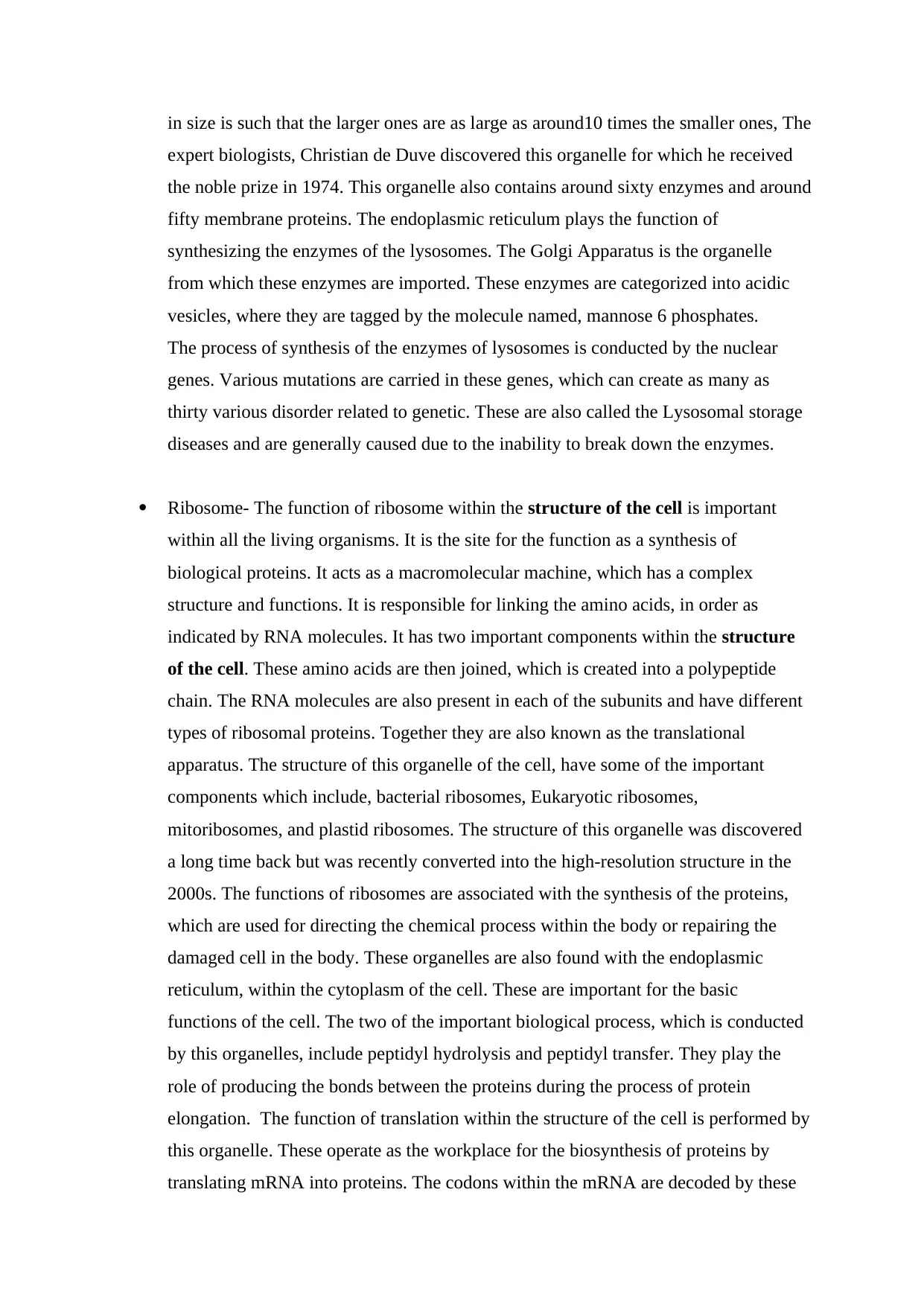
in size is such that the larger ones are as large as around10 times the smaller ones, The
expert biologists, Christian de Duve discovered this organelle for which he received
the noble prize in 1974. This organelle also contains around sixty enzymes and around
fifty membrane proteins. The endoplasmic reticulum plays the function of
synthesizing the enzymes of the lysosomes. The Golgi Apparatus is the organelle
from which these enzymes are imported. These enzymes are categorized into acidic
vesicles, where they are tagged by the molecule named, mannose 6 phosphates.
The process of synthesis of the enzymes of lysosomes is conducted by the nuclear
genes. Various mutations are carried in these genes, which can create as many as
thirty various disorder related to genetic. These are also called the Lysosomal storage
diseases and are generally caused due to the inability to break down the enzymes.
Ribosome- The function of ribosome within the structure of the cell is important
within all the living organisms. It is the site for the function as a synthesis of
biological proteins. It acts as a macromolecular machine, which has a complex
structure and functions. It is responsible for linking the amino acids, in order as
indicated by RNA molecules. It has two important components within the structure
of the cell. These amino acids are then joined, which is created into a polypeptide
chain. The RNA molecules are also present in each of the subunits and have different
types of ribosomal proteins. Together they are also known as the translational
apparatus. The structure of this organelle of the cell, have some of the important
components which include, bacterial ribosomes, Eukaryotic ribosomes,
mitoribosomes, and plastid ribosomes. The structure of this organelle was discovered
a long time back but was recently converted into the high-resolution structure in the
2000s. The functions of ribosomes are associated with the synthesis of the proteins,
which are used for directing the chemical process within the body or repairing the
damaged cell in the body. These organelles are also found with the endoplasmic
reticulum, within the cytoplasm of the cell. These are important for the basic
functions of the cell. The two of the important biological process, which is conducted
by this organelles, include peptidyl hydrolysis and peptidyl transfer. They play the
role of producing the bonds between the proteins during the process of protein
elongation. The function of translation within the structure of the cell is performed by
this organelle. These operate as the workplace for the biosynthesis of proteins by
translating mRNA into proteins. The codons within the mRNA are decoded by these
expert biologists, Christian de Duve discovered this organelle for which he received
the noble prize in 1974. This organelle also contains around sixty enzymes and around
fifty membrane proteins. The endoplasmic reticulum plays the function of
synthesizing the enzymes of the lysosomes. The Golgi Apparatus is the organelle
from which these enzymes are imported. These enzymes are categorized into acidic
vesicles, where they are tagged by the molecule named, mannose 6 phosphates.
The process of synthesis of the enzymes of lysosomes is conducted by the nuclear
genes. Various mutations are carried in these genes, which can create as many as
thirty various disorder related to genetic. These are also called the Lysosomal storage
diseases and are generally caused due to the inability to break down the enzymes.
Ribosome- The function of ribosome within the structure of the cell is important
within all the living organisms. It is the site for the function as a synthesis of
biological proteins. It acts as a macromolecular machine, which has a complex
structure and functions. It is responsible for linking the amino acids, in order as
indicated by RNA molecules. It has two important components within the structure
of the cell. These amino acids are then joined, which is created into a polypeptide
chain. The RNA molecules are also present in each of the subunits and have different
types of ribosomal proteins. Together they are also known as the translational
apparatus. The structure of this organelle of the cell, have some of the important
components which include, bacterial ribosomes, Eukaryotic ribosomes,
mitoribosomes, and plastid ribosomes. The structure of this organelle was discovered
a long time back but was recently converted into the high-resolution structure in the
2000s. The functions of ribosomes are associated with the synthesis of the proteins,
which are used for directing the chemical process within the body or repairing the
damaged cell in the body. These organelles are also found with the endoplasmic
reticulum, within the cytoplasm of the cell. These are important for the basic
functions of the cell. The two of the important biological process, which is conducted
by this organelles, include peptidyl hydrolysis and peptidyl transfer. They play the
role of producing the bonds between the proteins during the process of protein
elongation. The function of translation within the structure of the cell is performed by
this organelle. These operate as the workplace for the biosynthesis of proteins by
translating mRNA into proteins. The codons within the mRNA are decoded by these
Paraphrase This Document
Need a fresh take? Get an instant paraphrase of this document with our AI Paraphraser
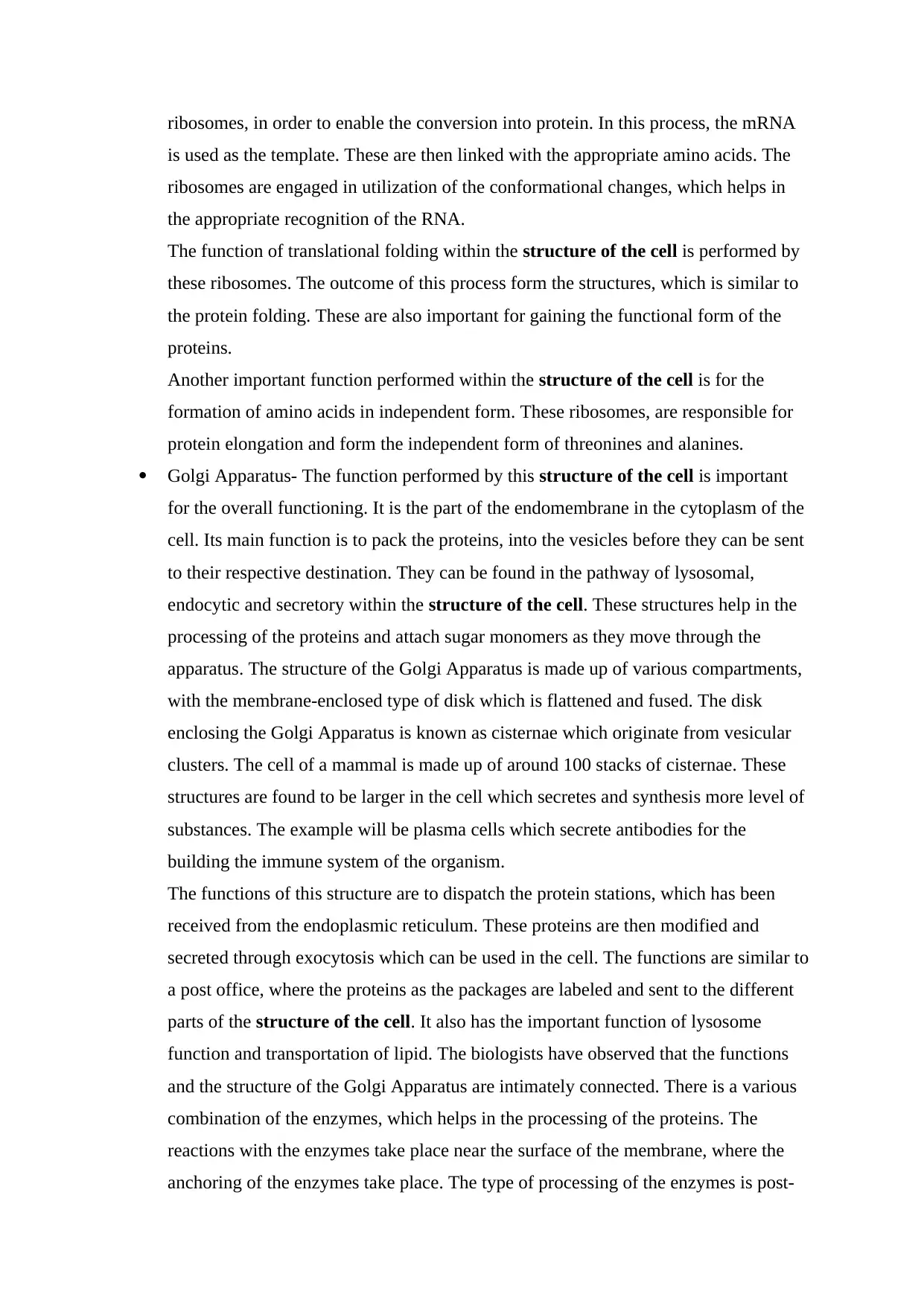
ribosomes, in order to enable the conversion into protein. In this process, the mRNA
is used as the template. These are then linked with the appropriate amino acids. The
ribosomes are engaged in utilization of the conformational changes, which helps in
the appropriate recognition of the RNA.
The function of translational folding within the structure of the cell is performed by
these ribosomes. The outcome of this process form the structures, which is similar to
the protein folding. These are also important for gaining the functional form of the
proteins.
Another important function performed within the structure of the cell is for the
formation of amino acids in independent form. These ribosomes, are responsible for
protein elongation and form the independent form of threonines and alanines.
Golgi Apparatus- The function performed by this structure of the cell is important
for the overall functioning. It is the part of the endomembrane in the cytoplasm of the
cell. Its main function is to pack the proteins, into the vesicles before they can be sent
to their respective destination. They can be found in the pathway of lysosomal,
endocytic and secretory within the structure of the cell. These structures help in the
processing of the proteins and attach sugar monomers as they move through the
apparatus. The structure of the Golgi Apparatus is made up of various compartments,
with the membrane-enclosed type of disk which is flattened and fused. The disk
enclosing the Golgi Apparatus is known as cisternae which originate from vesicular
clusters. The cell of a mammal is made up of around 100 stacks of cisternae. These
structures are found to be larger in the cell which secretes and synthesis more level of
substances. The example will be plasma cells which secrete antibodies for the
building the immune system of the organism.
The functions of this structure are to dispatch the protein stations, which has been
received from the endoplasmic reticulum. These proteins are then modified and
secreted through exocytosis which can be used in the cell. The functions are similar to
a post office, where the proteins as the packages are labeled and sent to the different
parts of the structure of the cell. It also has the important function of lysosome
function and transportation of lipid. The biologists have observed that the functions
and the structure of the Golgi Apparatus are intimately connected. There is a various
combination of the enzymes, which helps in the processing of the proteins. The
reactions with the enzymes take place near the surface of the membrane, where the
anchoring of the enzymes take place. The type of processing of the enzymes is post-
is used as the template. These are then linked with the appropriate amino acids. The
ribosomes are engaged in utilization of the conformational changes, which helps in
the appropriate recognition of the RNA.
The function of translational folding within the structure of the cell is performed by
these ribosomes. The outcome of this process form the structures, which is similar to
the protein folding. These are also important for gaining the functional form of the
proteins.
Another important function performed within the structure of the cell is for the
formation of amino acids in independent form. These ribosomes, are responsible for
protein elongation and form the independent form of threonines and alanines.
Golgi Apparatus- The function performed by this structure of the cell is important
for the overall functioning. It is the part of the endomembrane in the cytoplasm of the
cell. Its main function is to pack the proteins, into the vesicles before they can be sent
to their respective destination. They can be found in the pathway of lysosomal,
endocytic and secretory within the structure of the cell. These structures help in the
processing of the proteins and attach sugar monomers as they move through the
apparatus. The structure of the Golgi Apparatus is made up of various compartments,
with the membrane-enclosed type of disk which is flattened and fused. The disk
enclosing the Golgi Apparatus is known as cisternae which originate from vesicular
clusters. The cell of a mammal is made up of around 100 stacks of cisternae. These
structures are found to be larger in the cell which secretes and synthesis more level of
substances. The example will be plasma cells which secrete antibodies for the
building the immune system of the organism.
The functions of this structure are to dispatch the protein stations, which has been
received from the endoplasmic reticulum. These proteins are then modified and
secreted through exocytosis which can be used in the cell. The functions are similar to
a post office, where the proteins as the packages are labeled and sent to the different
parts of the structure of the cell. It also has the important function of lysosome
function and transportation of lipid. The biologists have observed that the functions
and the structure of the Golgi Apparatus are intimately connected. There is a various
combination of the enzymes, which helps in the processing of the proteins. The
reactions with the enzymes take place near the surface of the membrane, where the
anchoring of the enzymes take place. The type of processing of the enzymes is post-
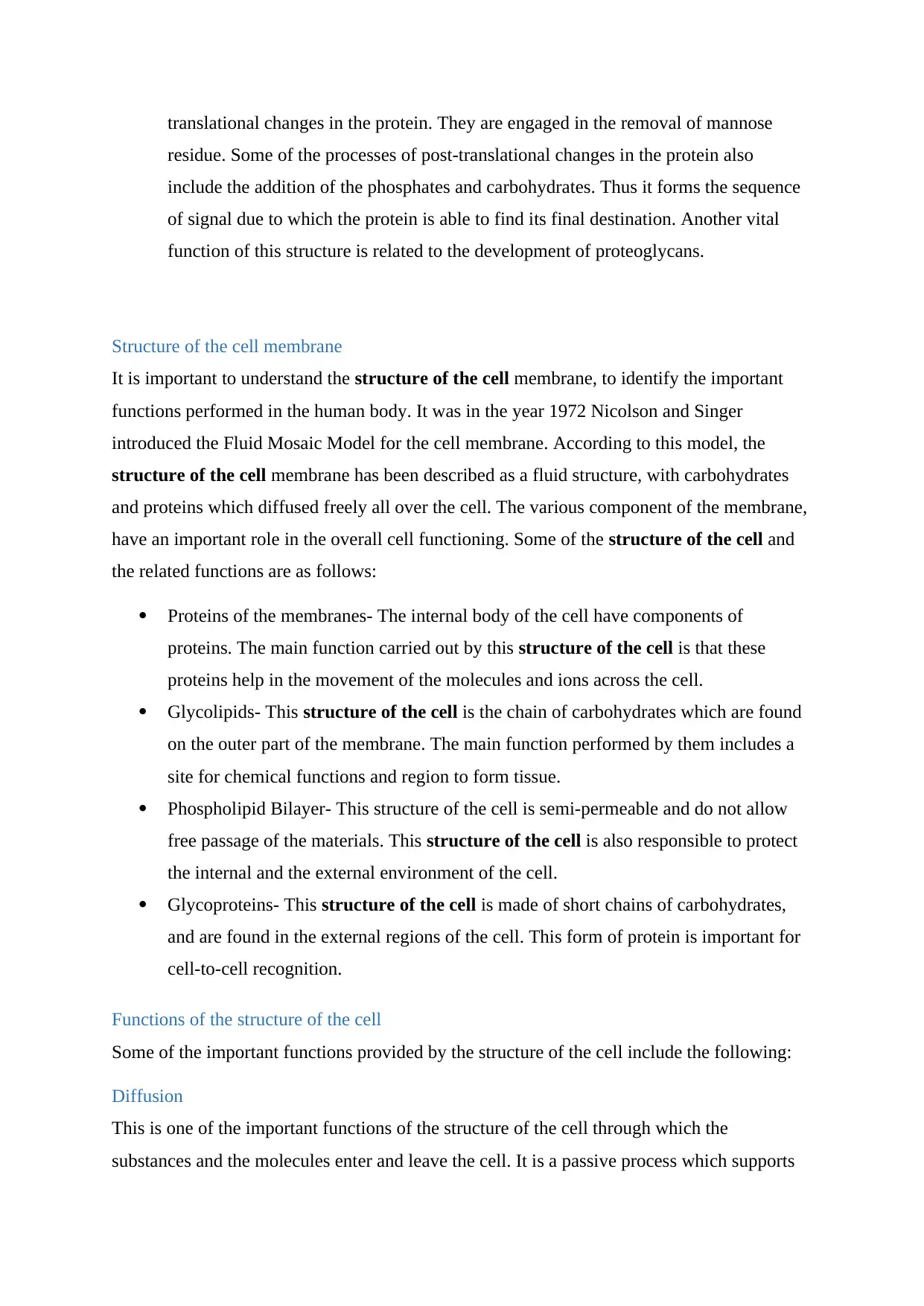
translational changes in the protein. They are engaged in the removal of mannose
residue. Some of the processes of post-translational changes in the protein also
include the addition of the phosphates and carbohydrates. Thus it forms the sequence
of signal due to which the protein is able to find its final destination. Another vital
function of this structure is related to the development of proteoglycans.
Structure of the cell membrane
It is important to understand the structure of the cell membrane, to identify the important
functions performed in the human body. It was in the year 1972 Nicolson and Singer
introduced the Fluid Mosaic Model for the cell membrane. According to this model, the
structure of the cell membrane has been described as a fluid structure, with carbohydrates
and proteins which diffused freely all over the cell. The various component of the membrane,
have an important role in the overall cell functioning. Some of the structure of the cell and
the related functions are as follows:
Proteins of the membranes- The internal body of the cell have components of
proteins. The main function carried out by this structure of the cell is that these
proteins help in the movement of the molecules and ions across the cell.
Glycolipids- This structure of the cell is the chain of carbohydrates which are found
on the outer part of the membrane. The main function performed by them includes a
site for chemical functions and region to form tissue.
Phospholipid Bilayer- This structure of the cell is semi-permeable and do not allow
free passage of the materials. This structure of the cell is also responsible to protect
the internal and the external environment of the cell.
Glycoproteins- This structure of the cell is made of short chains of carbohydrates,
and are found in the external regions of the cell. This form of protein is important for
cell-to-cell recognition.
Functions of the structure of the cell
Some of the important functions provided by the structure of the cell include the following:
Diffusion
This is one of the important functions of the structure of the cell through which the
substances and the molecules enter and leave the cell. It is a passive process which supports
residue. Some of the processes of post-translational changes in the protein also
include the addition of the phosphates and carbohydrates. Thus it forms the sequence
of signal due to which the protein is able to find its final destination. Another vital
function of this structure is related to the development of proteoglycans.
Structure of the cell membrane
It is important to understand the structure of the cell membrane, to identify the important
functions performed in the human body. It was in the year 1972 Nicolson and Singer
introduced the Fluid Mosaic Model for the cell membrane. According to this model, the
structure of the cell membrane has been described as a fluid structure, with carbohydrates
and proteins which diffused freely all over the cell. The various component of the membrane,
have an important role in the overall cell functioning. Some of the structure of the cell and
the related functions are as follows:
Proteins of the membranes- The internal body of the cell have components of
proteins. The main function carried out by this structure of the cell is that these
proteins help in the movement of the molecules and ions across the cell.
Glycolipids- This structure of the cell is the chain of carbohydrates which are found
on the outer part of the membrane. The main function performed by them includes a
site for chemical functions and region to form tissue.
Phospholipid Bilayer- This structure of the cell is semi-permeable and do not allow
free passage of the materials. This structure of the cell is also responsible to protect
the internal and the external environment of the cell.
Glycoproteins- This structure of the cell is made of short chains of carbohydrates,
and are found in the external regions of the cell. This form of protein is important for
cell-to-cell recognition.
Functions of the structure of the cell
Some of the important functions provided by the structure of the cell include the following:
Diffusion
This is one of the important functions of the structure of the cell through which the
substances and the molecules enter and leave the cell. It is a passive process which supports
⊘ This is a preview!⊘
Do you want full access?
Subscribe today to unlock all pages.

Trusted by 1+ million students worldwide
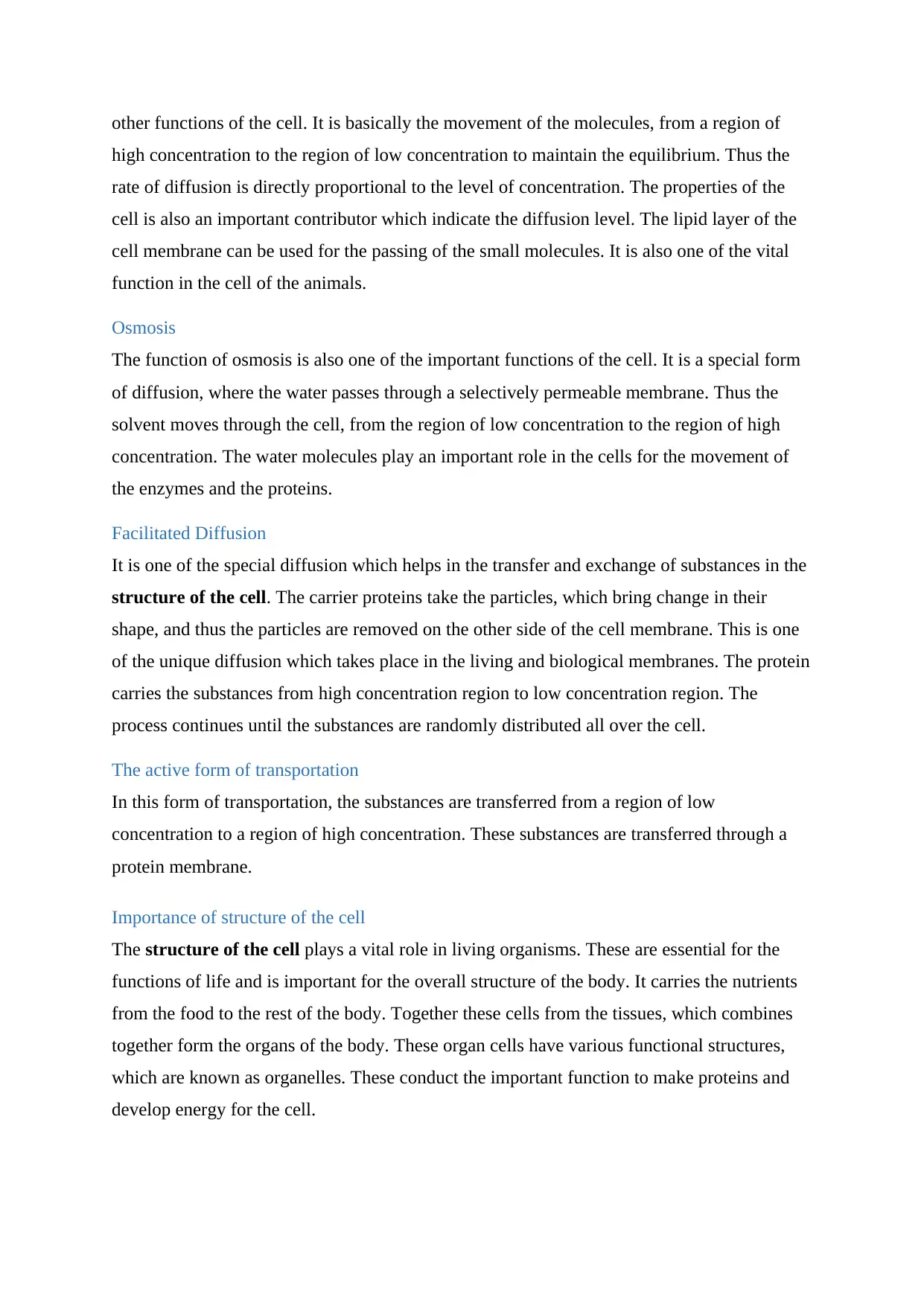
other functions of the cell. It is basically the movement of the molecules, from a region of
high concentration to the region of low concentration to maintain the equilibrium. Thus the
rate of diffusion is directly proportional to the level of concentration. The properties of the
cell is also an important contributor which indicate the diffusion level. The lipid layer of the
cell membrane can be used for the passing of the small molecules. It is also one of the vital
function in the cell of the animals.
Osmosis
The function of osmosis is also one of the important functions of the cell. It is a special form
of diffusion, where the water passes through a selectively permeable membrane. Thus the
solvent moves through the cell, from the region of low concentration to the region of high
concentration. The water molecules play an important role in the cells for the movement of
the enzymes and the proteins.
Facilitated Diffusion
It is one of the special diffusion which helps in the transfer and exchange of substances in the
structure of the cell. The carrier proteins take the particles, which bring change in their
shape, and thus the particles are removed on the other side of the cell membrane. This is one
of the unique diffusion which takes place in the living and biological membranes. The protein
carries the substances from high concentration region to low concentration region. The
process continues until the substances are randomly distributed all over the cell.
The active form of transportation
In this form of transportation, the substances are transferred from a region of low
concentration to a region of high concentration. These substances are transferred through a
protein membrane.
Importance of structure of the cell
The structure of the cell plays a vital role in living organisms. These are essential for the
functions of life and is important for the overall structure of the body. It carries the nutrients
from the food to the rest of the body. Together these cells from the tissues, which combines
together form the organs of the body. These organ cells have various functional structures,
which are known as organelles. These conduct the important function to make proteins and
develop energy for the cell.
high concentration to the region of low concentration to maintain the equilibrium. Thus the
rate of diffusion is directly proportional to the level of concentration. The properties of the
cell is also an important contributor which indicate the diffusion level. The lipid layer of the
cell membrane can be used for the passing of the small molecules. It is also one of the vital
function in the cell of the animals.
Osmosis
The function of osmosis is also one of the important functions of the cell. It is a special form
of diffusion, where the water passes through a selectively permeable membrane. Thus the
solvent moves through the cell, from the region of low concentration to the region of high
concentration. The water molecules play an important role in the cells for the movement of
the enzymes and the proteins.
Facilitated Diffusion
It is one of the special diffusion which helps in the transfer and exchange of substances in the
structure of the cell. The carrier proteins take the particles, which bring change in their
shape, and thus the particles are removed on the other side of the cell membrane. This is one
of the unique diffusion which takes place in the living and biological membranes. The protein
carries the substances from high concentration region to low concentration region. The
process continues until the substances are randomly distributed all over the cell.
The active form of transportation
In this form of transportation, the substances are transferred from a region of low
concentration to a region of high concentration. These substances are transferred through a
protein membrane.
Importance of structure of the cell
The structure of the cell plays a vital role in living organisms. These are essential for the
functions of life and is important for the overall structure of the body. It carries the nutrients
from the food to the rest of the body. Together these cells from the tissues, which combines
together form the organs of the body. These organ cells have various functional structures,
which are known as organelles. These conduct the important function to make proteins and
develop energy for the cell.
Paraphrase This Document
Need a fresh take? Get an instant paraphrase of this document with our AI Paraphraser

The structure of the cell has a nucleus which controls all the functions of the cell and is also
known as the control room. The genome within the nucleus also helps in the functions of the
cell.
known as the control room. The genome within the nucleus also helps in the functions of the
cell.
1 out of 8
Related Documents
Your All-in-One AI-Powered Toolkit for Academic Success.
+13062052269
info@desklib.com
Available 24*7 on WhatsApp / Email
![[object Object]](/_next/static/media/star-bottom.7253800d.svg)
Unlock your academic potential
Copyright © 2020–2025 A2Z Services. All Rights Reserved. Developed and managed by ZUCOL.





